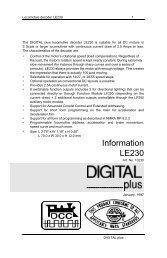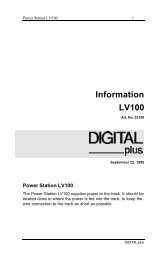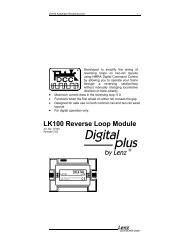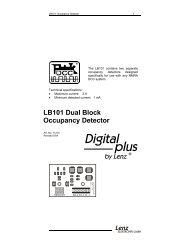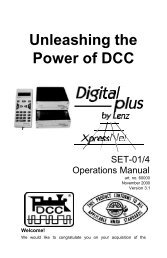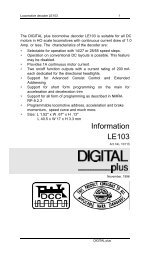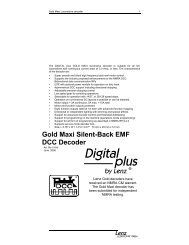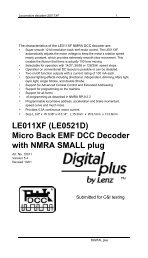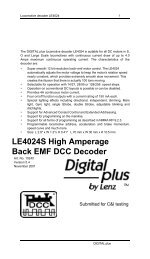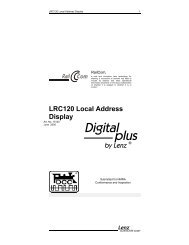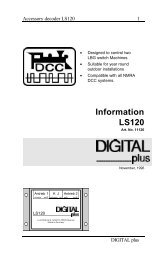LE122 Decoder Manual in PDF - Lenz USA
LE122 Decoder Manual in PDF - Lenz USA
LE122 Decoder Manual in PDF - Lenz USA
You also want an ePaper? Increase the reach of your titles
YUMPU automatically turns print PDFs into web optimized ePapers that Google loves.
12 Locomotive decoder <strong>LE122</strong> Locomotive decoder <strong>LE122</strong> 1Year One: A full repair or replacement will be provided to the orig<strong>in</strong>al purchaser for anyitem that that has failed due to manufacturer defects or failures caused by accidental user<strong>in</strong>stallation problems. Should the item no longer be produced and the item is not repairable,a similar item will be substituted at the manufacturers discretion. The user must pay forshipp<strong>in</strong>g to an authorized <strong>Lenz</strong> GmbH warranty center.Year 2 and 3: A full replacement for any item will be provided that has failed due tomanufacturer defects. If the failure was caused by accidental user <strong>in</strong>stallation or use, am<strong>in</strong>imal service charge may be imposed. Should the item no longer be produced and theitem is not repairable, a similar item will be substituted at the manufacturer discretion. Theuser must pay shipp<strong>in</strong>g to and from the authorized <strong>Lenz</strong> GmbH warranty center dur<strong>in</strong>g thisportion of the warranty period.Year 4-10: A m<strong>in</strong>imal service charge will be placed on each item that has failed due tomanufacturer defects and/or accidental user <strong>in</strong>stallation problems. Should the item no longerbe produced and the item is not repairable, a similar item will be substituted at themanufacturer discretion. The user must pay shipp<strong>in</strong>g to and from the authorized <strong>Lenz</strong>GmbH warranty center dur<strong>in</strong>g this portion of the warranty period.Please contact your dealer or authorized <strong>Lenz</strong> GmbH warranty center for specific<strong>in</strong>structions and current service charges prior to return<strong>in</strong>g any equipment for repair.Hüttenbergstraße 2935398 Gießen, GermanyHotl<strong>in</strong>e: 06403 900 133Fax: 06403 5332http://www.lenz.com<strong>Lenz</strong> Agency of North AmericaPO Box 143Chelmsford, MA 01824ph/fax: 978 250 1494support@lenz.comThis equipment complies with Part 15 of FCC Rules. Operation is subject to thefollow<strong>in</strong>g two conditions: (1) this device may not cause harmful <strong>in</strong>terference, and(2) this device must accept any <strong>in</strong>terference received, <strong>in</strong>clud<strong>in</strong>g <strong>in</strong>terference thatmay cause undesired operation.The DIGITAL plus locomotive decoder <strong>LE122</strong> is suitable for locomotives with fieldcoil motors (Märkl<strong>in</strong>, Hag). An LE 122 must not be operated on conventional ACpoweredlayouts!The characteristics of the decoder are:∗ Selectable for operation with 14/27, or 28/55 speed steps.∗ Operation on conventional DC layouts is possible. This feature may bedisabled.∗ Provides 1A cont<strong>in</strong>uous motor current.∗ Four on/off function outputs with a current rat<strong>in</strong>g of 200 mA each. Two of thefunction outputs are dedicated for the directional headlights.∗ Support for Advanced Consist Control and Extended Address<strong>in</strong>g∗ Support for short form programm<strong>in</strong>g on the ma<strong>in</strong> for acceleration anddeceleration trim∗ Uses <strong>in</strong>dustry standard 9 p<strong>in</strong> decoder plug/socket∗ Support for all form of programm<strong>in</strong>g as described <strong>in</strong> NMRA RP-9.2.3∗ Programmable locomotive address, acceleration and brake momentum,speed curve and much more.∗ Size: L 1.04" x W 0.67"x H 0.26"L 34 x W 17 x H 6.5 mm<strong>LE122</strong>DCC <strong>Decoder</strong> forUniveral MotorsArt. No. 10122January 1999Please save this manual for future reference!© 1998 <strong>Lenz</strong> GmbH, All Rights ReservedDIGITAL plus
2 Locomotive decoder <strong>LE122</strong> Locomotive decoder <strong>LE122</strong> 11LE 122 must not be operated onconventional AC-powered layouts!The <strong>LE122</strong> is packed with features you expect <strong>in</strong> a high enddecoder. Advanced consist control, extended address<strong>in</strong>g,outstand<strong>in</strong>g 28 step motor control, and 4 function outputs (twofor directional headlight control) are but a few examples. The<strong>LE122</strong> supports all forms of programm<strong>in</strong>g described <strong>in</strong> NMRARecommended Practice 9.2.3, <strong>in</strong>clud<strong>in</strong>g the user friendly directCV programm<strong>in</strong>g mode. Also, standard is a built <strong>in</strong> self-testprocedure. The advantages of this standardization are obvious:Every locomotive decoder responds <strong>in</strong> the same way to changes<strong>in</strong> their properties. All new DIGITAL plus locomotive decodersare produced accord<strong>in</strong>g to these NMRA DCC standards. Thisstandardization will greatly improve <strong>in</strong>teroperability of locomotivedecoders for all manufacturers.DIGITAL plus decoders built to the NMRA standards andrecommended practices are labeled:Many characteristics of the <strong>LE122</strong> decoder can be programmedto customize the decoder to its locomotive. For example, youcan operate the decoder with the factory pre-set speed table orgenerate your own. You can set which end of the locomotive isthe forward end. You can even decide whether or not you wantto be able to operate on conventional DC layouts.Please read “The Configuration Variables and Their Mean<strong>in</strong>gs”section later <strong>in</strong> this booklet for details on the configurationvariables supported by the <strong>LE122</strong>. There you will f<strong>in</strong>d muchmore <strong>in</strong>formation regard<strong>in</strong>g the features and their respectivesett<strong>in</strong>gs.First, we will describe how to <strong>in</strong>stall the decoder <strong>in</strong> yourlocomotive.Creat<strong>in</strong>g a Speed CurveStart by writ<strong>in</strong>g down how you want to assign the <strong>in</strong>ternal speedsett<strong>in</strong>gs to the speed steps, for example by mak<strong>in</strong>g up a table asshown below. The table shown is just an example and gives thefactory pre-set speed curve for a start<strong>in</strong>g speed of 1.In the follow<strong>in</strong>g description, we will assume that the decoder isproperly <strong>in</strong>stalled and tested, and the locomotive is on theprogramm<strong>in</strong>g track with the power on. We assume you arefamiliar with the general process of programm<strong>in</strong>g us<strong>in</strong>g yourcommand station.Speed step <strong>in</strong>14/27 modeWarrantySpeedstep <strong>in</strong> 28modeInternalspeedsett<strong>in</strong>gCV /register1 1 1 672 3 3 683 5 5 694 7 7 705 9 9 716 11 12 727 13 15 738 15 19 749 17 23 7510 19 28 7611 21 34 7712 23 42 7813 25 52 7914 27 60 80-- 28 63 81<strong>Lenz</strong> GmbH does everyth<strong>in</strong>g it can do to ensure that its products are free fromdefects and will operate for the life of your model railroad equipment. From time totime even the best eng<strong>in</strong>eered products fail either due to a faulty part or fromaccidental mistakes <strong>in</strong> <strong>in</strong>stallation. To protect your <strong>in</strong>vestment <strong>in</strong> DIGITAL plusproducts. <strong>Lenz</strong> GmbH offers a very aggressive 10 year Limited Warranty.This warranty is not valid if the user has altered, <strong>in</strong>tentionally misused the DIGITALplus product, or removed the product's protection, for example the heat shr<strong>in</strong>k fromdecoders and other devices. In this case a service charge will be applied for allrepairs or replacements. Should the user desire to alter a DIGITAL plus Product,they should contact <strong>Lenz</strong> GmbH for prior authorization.DIGITAL plus
10 Locomotive decoder <strong>LE122</strong> Locomotive decoder <strong>LE122</strong> 3CV Description Range Sett<strong>in</strong>g30 <strong>Decoder</strong> Error Informationbit 1 Motor Short0,1 0If set short between motor and trackbit 2 Front Headlight Short0,1 0If set the front headlight is shortedbit 5 Rear Headlight Short0,1 0If set the rear headlight is shorted1 user def<strong>in</strong>ed speed curve is used. Pleaseenter the appropriate values <strong>in</strong>to CV 67 to 80before sett<strong>in</strong>g this bit.60 <strong>Decoder</strong> Configuration, byte 2:Similar to CV 29, but other properties are set withthis byte:bit 1 always 0 0 0bit 2 <strong>Decoder</strong> Control Active0,1 1If set CV30 conta<strong>in</strong>s decoder errorbit 3 Brake momentum on DC operation. 0,1 0This sett<strong>in</strong>g is only active with conventionalDC operation disabled. (CV 29, bit 3 = 0)This sett<strong>in</strong>g can be used to achieveprototypical brak<strong>in</strong>g at red signal <strong>in</strong>dications.0 locomotive proceeds with track voltagedependent speed <strong>in</strong>side the conventionalsection.1 locomotive brakes <strong>in</strong> the conventionalsection with pre set brake momentum.bits always 0 0 04-867to81Values for user def<strong>in</strong>ed speed curve:These registers are used for a user def<strong>in</strong>ed speedcurve. The factory sett<strong>in</strong>g for these registers is 0. Ifyou are try<strong>in</strong>g to use this speed curve unmodified,your locomotive will not move!The value <strong>in</strong> each register determ<strong>in</strong>es the velocity ofthe locomotive for each assigned speed step:For the 14 speed step mode, speed step 1 is us<strong>in</strong>gthe value <strong>in</strong> CV 67, speed step 2 the value <strong>in</strong> CV 68,speed step 3 the value <strong>in</strong> CV 69, etc.For the 28 speed step mode, speed step 1 is us<strong>in</strong>gthe value <strong>in</strong> CV67, speed step 3 the value <strong>in</strong> CV 68,speed step 5 the value <strong>in</strong> CV 69, etc. The<strong>in</strong>termediate speed steps are calculated by thedecoder.0-63 0Prepar<strong>in</strong>g to Install the <strong>LE122</strong>The locomotive must be tested for excellent operation on normalDC power before <strong>in</strong>stall<strong>in</strong>g the decoder. Replace worn out motorbrushes and burned out light bulbs. Clean any dirt or oxidationfrom the wheels and pickups, and make sure that electricalcontact is smooth. Now is also a good time to lubricate yourlocomotive. Only a locomotive with impeccable mechanicalperformance will perform well with the decoder.Take note which motor brush is connected to the right rail andwhich to the left rail. This <strong>in</strong>formation allows you to connect thedecoder to the motor with the correct polarity.The <strong>LE122</strong> is quite small and will fit <strong>in</strong>to most HO locomotiveseven those with narrow hoods.Some advice on the current draw of the decoderoutput:The current for all the decoder outputs is supplied by an <strong>in</strong>ternalrectifier with a maximum current rat<strong>in</strong>g of 1.2 Amps. The sum ofall currents to the motor and the function outputs cannot exceedthis limit. Each <strong>in</strong>dividual output can only draw up to it's limit.Summ<strong>in</strong>g up the <strong>in</strong>dividual current limits leads to a numberlarger than 1.2 Amps, but they still are not permitted to drawmore than this limit.Example:Suppose the motor may require as much as 1.0 A cont<strong>in</strong>uously.Then the function outputs comb<strong>in</strong>ed must not exceed 0.2 A. Ifthe directional headlights require 50 mA each, then the load onfunction 1 and 2 must not exceed 150 mA.Some advice on <strong>in</strong>stall<strong>in</strong>g the decoder:Although the <strong>LE122</strong> has many <strong>in</strong>ternal safeguards to preventdamage, you must not allow any metal part of the locomotive totouch the surface components of the decoder. This could causea direct <strong>in</strong>ternal short circuit and the decoder will be destroyed.DO NOT WRAP decoder with electrician’s tape or shr<strong>in</strong>k-DIGITAL plus
4 Locomotive decoder <strong>LE122</strong> Locomotive decoder <strong>LE122</strong> 9wrap!Do<strong>in</strong>g so will impede air circulation and degrade the performanceof the decoder. Instead, put electrician tape over any part of thelocomotive frame or body that might touch the decoder. Thisway, you will prevent short circuits without 'suffocat<strong>in</strong>g' thedecoder.The shr<strong>in</strong>k-wrap over a part of the locomotive decoder protectsstatic sensitive parts and must not be removed. Install thedecoder us<strong>in</strong>g the provided double-sided tape.After disconnect<strong>in</strong>g the wir<strong>in</strong>g from the motor brushes, thebrushes MUST be isolated from the rail pickup. Achiev<strong>in</strong>gisolation may require some different approaches on differentlocomotives, perhaps unsolder<strong>in</strong>g wires, plac<strong>in</strong>g a th<strong>in</strong> piece of<strong>in</strong>sulat<strong>in</strong>g plastic between brush term<strong>in</strong>al and contact spr<strong>in</strong>g. Inother words, after isolation there must be NO electrical contactbetween the motor and the rail pickup. If you have a VOM,check for <strong>in</strong>f<strong>in</strong>ite resistance between the motor and all thewheels. Take special note that metal contact might occur onlywhen the loco body is re<strong>in</strong>stalled.The <strong>LE122</strong> can not be set up for simultaneous use for 2-railpickup and overhead cantenary or trolley operation. If thelocomotive is turned the wrong way, the decoder could gettwice the track voltage, which would destroy it!Wir<strong>in</strong>g OptionsThere are two wir<strong>in</strong>g options for <strong>in</strong>stall<strong>in</strong>g the <strong>LE122</strong>, depend<strong>in</strong>gon how the locomotive is constructed. The directional headlightfunctions could be connected with their common to the trackvoltage as shown <strong>in</strong> Figure 1, or, use the decoders float<strong>in</strong>gcommon as shown <strong>in</strong> Figure 2. A mixture of both options is alsopossible.If the bulbs for the directional headlights are float<strong>in</strong>g (isolatedaga<strong>in</strong>st wheel pick up and chassis) and connected accord<strong>in</strong>g toFigure 2, they will sh<strong>in</strong>e brighter compared to the option shownto Figure 1. Furthermore, the directional headlights will functionwhile operat<strong>in</strong>g on conventional DC layouts.CV R Description Range Sett<strong>in</strong>g29 *5 <strong>Decoder</strong> Configuration, Byte 1:0-55 4Several decoder properties are set with thisbyte. Changes are best done <strong>in</strong> b<strong>in</strong>ary mode(see the <strong>in</strong>formation for the Hand Held LH100).When Register 6 has a value of one CV 29 isalso available <strong>in</strong> Register 5The detailed properties are:bit 1 locomotive direction:0,1 00 normal: locomotive moves forward whenthe arrow on the Hand Held po<strong>in</strong>ts up.1 <strong>in</strong>verted: locomotive moves forward whenthe arrow on the Hand Held po<strong>in</strong>ts down.bit 2 speed step mode:0,1 00 Operation with 14 or 27 speed steps.This sett<strong>in</strong>g is selected when the locomotivedecoder is used with a software belowversion 2.0, ROCO-Digital, LGB-Digital,Arnold Digital and with all other Digitalsystems that do not support the 28 speedstep mode.1 Operation with 28 speed steps.This sett<strong>in</strong>g is selected when the locomotivedecoder is used with a Command Stationwith software version 2.0 or higher. TheCommand Station has to be set to 28 speedstep mode for the decoder address, if youare us<strong>in</strong>g this sett<strong>in</strong>g!Other Digital systems support<strong>in</strong>g the 28speed step mode can use the decoder <strong>in</strong> thissett<strong>in</strong>g.bit 3 Usage on conventional DC layouts: 0,1 10 locomotive operates <strong>in</strong> digital mode only1 locomotive can operate <strong>in</strong> bothconventional DC and digital mode.bit 4 always 0 0 0bit 5 speed curve:0,1 00 factory pre-set speed curve is used1 user def<strong>in</strong>ed speed curve is used. Pleaseenter the appropriate values <strong>in</strong>to CV 67 to 80before sett<strong>in</strong>g this bit.bit 6 Extended Address<strong>in</strong>g0-1 00= Normal address<strong>in</strong>g1=Two Byte extended address<strong>in</strong>gbit 7bit 8always 0 0 0DIGITAL plus
8 Locomotive decoder <strong>LE122</strong> Locomotive decoder <strong>LE122</strong> 5scheme of 1-8 to correspond to the 1-8 display on DIGITAL plussystems. Many other systems use a scheme of 0-7 to refer tothe <strong>in</strong>dividual bits. If you are us<strong>in</strong>g such a system you shouldsubtract one from all bit numbers described <strong>in</strong> these CVs.CVRegTable 1: <strong>LE122</strong> Configuration VariablesDescription Range Factorysett<strong>in</strong>g1 1 Locomotive address:1-127 3This is the number with which you select alocomotive <strong>in</strong> the DIGITAL plus system.2 2 Start voltage:1-15 8This is the voltage applied to the motor <strong>in</strong> speedstep 1. Set this value so that the locomotive juststarts mov<strong>in</strong>g <strong>in</strong> speed step 1.3 3 Acceleration Momentum:1-31 1Determ<strong>in</strong>es the rate of change of speed uponacceleration. A higher value leads to a sloweracceleration.4 4 Brake Momentum:1-31 1Determ<strong>in</strong>es the rate of change of speed uponbrak<strong>in</strong>g. A higher value leads to longer brakedistance.- 5 CV29 when the page/po<strong>in</strong>ter register has a 0-55 4value of 1 or value of CV po<strong>in</strong>ted to byRegister 6 when register 6 is be<strong>in</strong>g used asa po<strong>in</strong>ter register- 6 Page/Po<strong>in</strong>ter Register:0-127 1Used dur<strong>in</strong>g programm<strong>in</strong>g for pag<strong>in</strong>g or<strong>in</strong>dex<strong>in</strong>g7 7 Version Number:- 41This location stores the version number of thedecoder. This location is read only.8 8 Manufacturers Identification:- 99This value is a code for the manufacturer of thedecoder, for the <strong>LE122</strong> naturally <strong>Lenz</strong> (99).This location is read only.17 - Extended Address High Byte 192- 023118 - Extended Address Low Byte0-255 0The two byte address if used is conta<strong>in</strong>ed <strong>in</strong>CV17+1819 - Consist AddressThe advanced consist address if used is stored<strong>in</strong> CV190-255 0Step by Step InstallationIf you operate your locomotive on 2-rail layouts, then connect theConnect the decoder to the track voltage pickups:• Red wire to right rail pickup• Black wire to the left rail pickupIf you use a locomotive for 3-rail pickup, then connect the• Red wire with the pickup shoe (center rail)• Black wire with the wheels, or as the case may be, thelocomotive frame.Figure 1: Wir<strong>in</strong>g the <strong>LE122</strong> us<strong>in</strong>gFigure 2: Wir<strong>in</strong>g the <strong>LE122</strong> us<strong>in</strong>g atrack voltage float<strong>in</strong>g common.DIGITAL plus
6 Locomotive decoder <strong>LE122</strong> Locomotive decoder <strong>LE122</strong> 7Connect the decoder to the motor term<strong>in</strong>als:• Orange wire to the term<strong>in</strong>al which orig<strong>in</strong>ally to the right rail• Gray wire to the term<strong>in</strong>al which was orig<strong>in</strong>ally to the left railNow connect the headlights:• White wire to the forward headlight. If the bulb is isolated,connect the blue wire to the other bulb term<strong>in</strong>al.• Yellow wire to the rear headlight. If the bulb is isolated, thenconnect the blue wire similarly.Place the locomotive (without the body) on the programm<strong>in</strong>gtrack and read back the locomotive address from the decoder. Ifthe decoder is properly <strong>in</strong>stalled, you will be able to read backthe factory pre-set address 03. Remove the locomotive from thetrack, and if necessary correct any wir<strong>in</strong>g errors.F<strong>in</strong>ally, connect the other functions of the decoder.The different options for function connections:When connect<strong>in</strong>g the functions of locomotive decoder <strong>LE122</strong>there are 2 options. The functions <strong>in</strong> the locomotive can eitherbe connected with their common wire to the locomotive frame,and thereby to a wheel pick-up, as shown <strong>in</strong> illustration 1, orpotential free (that is <strong>in</strong>sulated from wheel pick-ups and frame)as shown <strong>in</strong> illustration 2. It is also possible to mix bothconnection options; for <strong>in</strong>stance the lamps for the headlightsmay be connected to a wheel pick-up, and additional functions(ie. a smoke generator or remote controlled coupler) may beisolated.• Connect the green wire to the auxiliary function operated bythe '1' key on the Hand Held LH100• Connect the violet wire to the function operated by the '2'key on the Hand Held LH100If the auxiliary functions and/or the bulbs are isolated, connectthe blue wire to their common po<strong>in</strong>t as shown <strong>in</strong> Figure 2. Nowyou are ready to program the locomotive address and beg<strong>in</strong> testrunn<strong>in</strong>g.Programm<strong>in</strong>g the locomotive decoder <strong>LE122</strong>Locomotive address, acceleration and brake momentum and allother properties of the decoder can be changed as often asdesired. This process is called programm<strong>in</strong>g.The properties will be saved <strong>in</strong> non-volatile memory locations onthe locomotive decoder. The values will be permanently saved,even after disconnect<strong>in</strong>g the operat<strong>in</strong>g voltage. These memorylocations are called "Configuration Variables, or CVs" by theNMRA. The <strong>LE122</strong> has a total of 128 CVs. Not all of them areused at this time as many are reserved for future use.The read<strong>in</strong>g and writ<strong>in</strong>g of these values is done electronically, thelocomotive does not need to be opened after <strong>in</strong>itial <strong>in</strong>stallation ofthe decoder to read of later modify any CV value.Any NMRA DCC Command Station, such as the DIGITAL plusLZ100 and a Hand Held LH100 or an Interface LI100, can beused to program the locomotive decoder <strong>LE122</strong>. With oldercommand stations (<strong>in</strong>clud<strong>in</strong>g Arnold or Märkl<strong>in</strong>) the decodersupports <strong>in</strong>dex mode, a special form of register mode whichallows you to easily address all the CVs. Us<strong>in</strong>g the ArnoldCommander 6, or the ROCO 'DIGITAL is cool' command station,only register 1 (locomotive address) can be set. Many other DCCcommand stations support paged programm<strong>in</strong>g. The <strong>LE122</strong>supports this mode as well. Details for read<strong>in</strong>g and writ<strong>in</strong>g thedecoder’s configuration variables can be found <strong>in</strong> the manuals ofthe appropriate equipment.The configuration variables and their mean<strong>in</strong>gThe new l<strong>in</strong>e of <strong>Lenz</strong> advanced decoders, version 4.1, support afull range of features which are set up us<strong>in</strong>g a variety ofconfiguration variables. All the configuration variables arenumbered. These numbers are used dur<strong>in</strong>g programm<strong>in</strong>g and areidentical for all decoders that conform to the NMRA standards<strong>in</strong>dependent of the manufacturer. The follow<strong>in</strong>g table lists thevarious CVs supported <strong>in</strong> the <strong>LE122</strong> decoder. Both the New CVnumbers and the older Register numbers are provided for crossreference.Please note: Some CVs (such as CV29) have specific mean<strong>in</strong>gsfor each bit. The bit assignments <strong>in</strong> this table use a bit number<strong>in</strong>gDIGITAL plus



